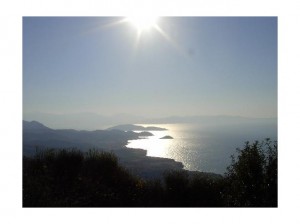 The north shore of Crete, especially around Mallia, is the most depressing part. While the land and seascapes are beautiful, the coast is stuffed with beach resorts overflowing with tacky tourist business, and seems to have been taken over by the Russian Mafia to sell furs. The signs of the immense fur emporia are always in Russian, occasionally in English, never in Greek. Why anyone would come to Crete to buy a fur coat baffles me. Wearing fur in this climate would kill you. Thankfully, the bus took us well past this vulgarity and we turned inland into the broad valley that forms the “neck” separating East Crete from the rest of the island.
The north shore of Crete, especially around Mallia, is the most depressing part. While the land and seascapes are beautiful, the coast is stuffed with beach resorts overflowing with tacky tourist business, and seems to have been taken over by the Russian Mafia to sell furs. The signs of the immense fur emporia are always in Russian, occasionally in English, never in Greek. Why anyone would come to Crete to buy a fur coat baffles me. Wearing fur in this climate would kill you. Thankfully, the bus took us well past this vulgarity and we turned inland into the broad valley that forms the “neck” separating East Crete from the rest of the island.
We were dropped off on an empty stretch of road near our destination, as we had requested. It was only a short walk along a dusty little side road before we found a marker for a trail that would lead us to the Valmiki Minoan site. The trail took us through some olive groves to a mound. The site was fenced off, and the gate locked with a rusted padlock, but it was easy enough to crawl under the fence. Within, there was what remained of a small Minoan town. Quite unimpressive, I know, after the spectacular Knossos. But here you could experience that delightful sense of mystery that you get from a remote or neglected archaeological site that is not impressive enough to please the tourist, but fills you with endorphins if you love history.
The endorphins were pumping fast in me, because the Minoan-ness of the ruins was evident. There was the central plaza, in miniature, and the same pattern of small sanctuaries, cells, pits and storage rooms. There was no mistaking this as a “palace.” All the points I made in the last blog post applied to this little site. Surrounding it was the same kind of irrigated an terraced agriculture, though the valley was somewhat drier and not as lush with vegetation. We didn’t stay long, as there was not very much to see, but this little mini-Knossos was quite important to me, and the experience had its own distinctive texture.
Across the valley was the Gorge of Monastiraki, near which was supposed to be another archaeological site of interest to me. However, I had only read a verbal description of it in a reseach paper, and it was not clear exactly where it was, only that it must be on high ground and somewhere near the entrance to the gorge.
The mountains here form a long, high wall across the island, rising steeply from nearly sea level to a plateau about three thousand feet high, and further in there peaks that go considerably higher. This massif looms like the wall in The Game of Thrones fantasy series. Behind that wall is the land, it is thought, to which the Minoans fled who would not be conquered or assimilated by the invading Mycenaeans. Centuries later, there were still a people there referred to as the Etiocretans in Greek literature, speaking an unknown language. These people are assumed to have been descendants of the Minoans. They may have survived into Roman times.
The location of the canyon was in no doubt for us. It can be seen from almost anywhere in the valley. It’s as if a giant axe descended from the sky and cut a gash from top to bottom of the mountain wall. Only a fantasy artist would invent a canyon so improbably dramatic. A bit to the south from the entrance is the village of Monastikiri. We could find no direct way to it from Valmiki, so we ended up following a twisting path through a few kilometers of olive groves until we came to a ridge and a staircase. This brought us up to small chapel, and then further up to a settling basin for irrigation water. Another few staircases, and we emerged in the village, in fact, in the courtyard of a taverna. There we met the owner, from whom we obtained a meal. We were the only customers. We asked for something distinctively Cretan. He served us baked aubergines stuffed with tomatoes, onions and roasted garlic. It was superb. He gave us directions to a trail which he thought might lead us to the canyon entrance, but he warned us that the authorities had forbidden access. Dangerous at the best of times, it was now menaced by flash floods, impassable pools, and rock falls.
We decided that we would at least look at the entrance, and perhaps enter as far as seemed safe. Finding the archaeological seemed unlikely, with no clues to its exact location. All I knew was that it was some sort of fortified stronghold in a high, defensive position.
Leaving our backpacks at the taverna, we followed the directions we were given, which did indeed lead to a path that wound up the mountain slope. We were constantly accompanied by goats, which made impossible leaps and bounds across the steep landscape. The path did not lead us to the canyon. Instead, it terminated at the Minoan fortress, perched on a high promontory spur of the mountain. There was no mistaking the now-familiar Minoan masonry. It was even more atmospheric than the Valmiki site, given the spectacular view of the valley all the way to the sea. It was clearly a sort of castleguarding the approach to the gorge. But further exploration beyond this point proved that the gorge could no longer be reached from this direction. Rockslides and tangles of fierce thorn bush blocked the way. The only viable approach was from the north, and would involve many kilometers of walking from where we were. It was getting pretty late in the day. So we returned to the taverna and formed a new plan.
A long, switchback dirt road rises from the village, climbing the mountain wall until it joins the paved road that comes up from the south coast and reaches the plateau. There is a village, according to the map, called Thrypti, and it is precisely at the point where the gorge reaches the top. We can at least find out what the plateau looks like, and what exactly the Etiocretans thought worth defending.
It was evening, now and we would have to sleep before undertaking such a climb. The tavernas owner offered to let us sleep in the courtyard, after he closed up shop. Filip preferred to sleep under the stars, somewhere out of the village. But the landscape, where it was not perpendicular, consisted entirely of sharp pebbles overgrown by vicious, multi-thorned weeds. He has a large backpack to put underneath him, and a thick sleeping bag. I have only a small rucksack and a warm, but very thin sleeping bag. I have dreadfull memories of sleeping on similar terrain in the reg of the Sahara. So I chose to kip out in the taverna courtyard, while Filip found his spot in the arms of raw nature.
But it was not to be. What followed was a scene from Nikos Kazantzakis. The taverna had been deserted during the day, but now people started to drift in. Eventually, there were about 35 people there, all engaged in animated conversation. There were young couples who arrived on motorbikes. There was an elderly French couple who spoke fluent Greek. There were families with small children. There were teenagers. People walked by on other errands, but could not resist staying to eat, drink and talk. A man arrived with a mandolin, and began to tune it. The owner of the taverna came out with a guitar to accompany him. They played and sang sad Greek songs, gently, never too loud or vigorously to interfere with the chatter of the diners, but giving it a sort of reinforcing rhythm. They were not so much performing as helping the people digest their food and giving sparkle to their conversation.
This was utterly fascinating and entertaining, but it was obvious that it would go on late into the night. I decided to join Filip where he was sleeping.
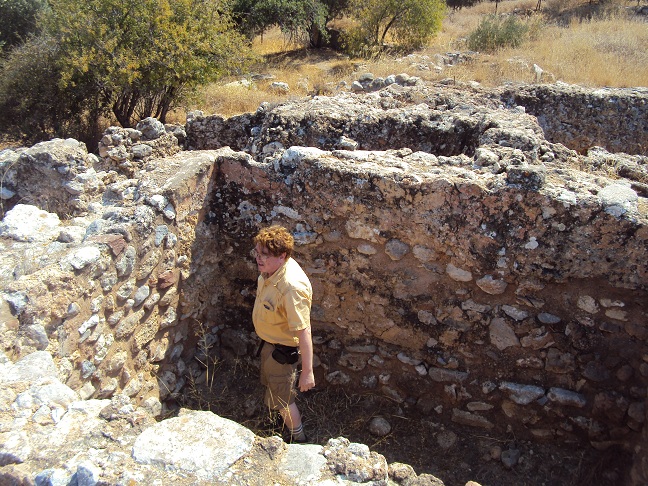
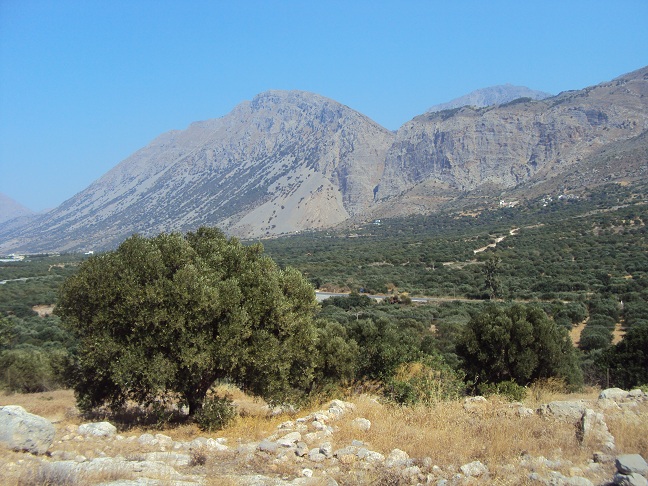
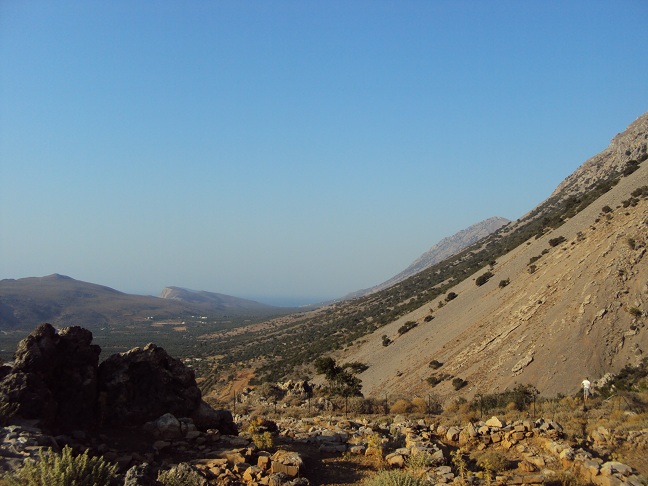
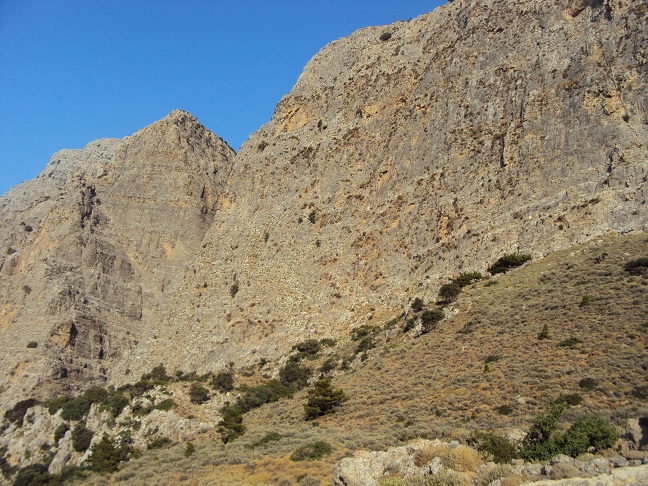
0 Comments.